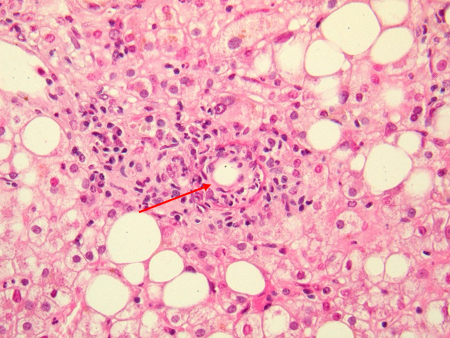History and exam
Key diagnostic factors
common
abrupt onset of high fever
The classic presentation of acute infection is a flu-like illness that includes abrupt onset of high fever (102°F to 104°F [39°C to 40°C]). The fever may be isolated and may last up to 14 days, or up to 57 days if untreated.[37]
flu-like illness
The classic presentation of acute infection is a flu-like illness that includes abrupt onset of high fever, chills, malaise, cough, headache, fatigue, and myalgia.[37]
severe headache
Associated with central nervous system involvement during acute infection.
cough
Patients with acute infection may present with pneumonia that is usually mild and presents with a cough (24% to 90% of patients).[37]
inspiratory crackles, rhonchi, or wheezing
These sounds may be heard during pulmonary auscultation of a patient with atypical pneumonia following acute Coxiella burnetii infection.
uncommon
hepatomegaly
Granulomatous hepatitis, particularly fibrin ringed, is another frequent presentation of acute infection; jaundice is rare, but hepatomegaly may be palpable.[Figure caption and citation for the preceding image starts]: Liver "doughnut granuloma" characteristic of acute Coxiella burnetii hepatitis. Note the specific granuloma morphology as a doughnut. No bacteria may be seen in this granulomaHubert Lepidi, Institut Hospitalo-Universitaire Méditerranée Infection [Citation ends].
Other diagnostic factors
uncommon
exanthemas
pleuritic chest pain
Patients with acute infection may present with pneumonia that is sometimes associated with pleuritic chest pain.[37]
seizures
Presentations associated with central nervous system involvement during acute C burnetii infection may present with seizures.[55]
coma
Presentations associated with central nervous system involvement during acute C burnetii infection may present with coma.[55]
chronic fatigue
signs of endocarditis or vascular infection (persistent focalized infection)
In a small proportion of patients, primary infection leads to persistent focalized infections. Endocarditis is the most common form of persistent focalized infection and occurs in up to 70% of cases.[2] It usually develops in patients with underlying heart disease.[5]
Peripheral manifestations of endocarditis are rarely present.[37] For these patients, fever is often absent, and vegetations are usually absent or small. There may be augmentation of a known heart murmur, signs of heart failure, and arterial emboli.
Vascular infections (e.g., aneurysm, vascular prosthetic infection) are also a common form of persistent focalized infection.
other signs of persistent focalized infection
Uncommon presentations of persistent focalized infection include osteoarticular infections (e.g., culture-negative prosthetic joint infection, spondylodiscitis, osteomyelitis, osteoarthritis), chronic lymphadenitis (patients presenting with chronic lymphadenitis may be at risk of lymphoma), chronic interstitial pneumonitis, lung pseudotumor, lung fibrosis, uveitis, optic neuritis, giant cell arteritis, or Takayasu arteritis.[66][67][68][69][70]
other signs of acute infection
Uncommon presentations of acute infection include acute endocarditis, myocarditis, pericarditis, myopericarditis, arterial or venous thrombosis, meningoencephalitis, meningitis, lymphadenitis, rhabdomyolysis, cholecystitis, gastroenteritis, pancreatitis, splenic rupture, mesenteric panniculitis, orchitis, epididymitis, priapism, thyroiditis, inappropriate secretion of antidiuretic hormone, or glomerulonephritis.
Risk factors
strong
exposure to infected animals
Infected animals shed the organism in birth products, as well as through urine, feces, and milk.
The most common animal reservoirs are sheep, goats, and calves, although multiple species may be infected and potentially transmit the disease to humans.
Products of parturition contain high numbers of bacteria that may become aerosolized after drying and thus remain infectious for months. The placenta of infected sheep contains up to 10⁹ organisms per gram of tissue. The spore-like forms are resistant to heat, desiccation, and multiple disinfectants, which confers viability for a prolonged time.
Inhalation of a low dose (1 to 10 bacteria) is sufficient to cause infection.[1][37]
Recent animal contact should be looked for during diagnostic workup, but an exposition history is frequently lacking.
occupational exposure
Workers in several occupations are at high risk of acquiring the infection, such as farmers, veterinarians, and abattoir workers.
Laboratory personnel are also at risk of infection.[26][27]Coxiella burnetii infection is the second most common laboratory-reported infection; outbreaks have been reported involving 15 or more people in some institutions.
Reports of the infection among military personnel stationed in Iraq and Afghanistan suggest that this is an occupationally acquired illness in this group.[20][21]
Recent animal contact should be looked for during diagnostic workup, but an exposition history is frequently lacking.
travel or residency in endemic areas
The infection has been reported in most countries, but not in New Zealand or Polynesia.[5]
The disease is endemic in Australia and strongly associated with the presence of both livestock and abattoirs.[5][9]
In the US, the incidence is high in the Midwest, although California has reported the highest number of total cases.[10]
The largest outbreak recorded to date occurred in the Netherlands between 2007 and 2009, with more than 4,000 cases reported.[12][13][14][15][16] The outbreak was mainly confined to the south of the country, and dairy goats were implicated as the source.
Cases have also been reported in Israel and Taiwan.[18][19]
Residents in endemic areas are at risk of acquiring the infection without direct contact with infected animals. Exposure to contaminated straw, manure, or wind-borne dust from farms has been linked to outbreaks of the disease.[43]
male sex
The infection is more commonly reported in men.[5] In Australia, men are 5 times more likely than women to develop the disease. In France, the infection is 2.5 times more likely in men. This may be related to greater occupational exposure in men or may be linked to the protective role of 17-beta-estradiol in women.[5][28]
age 30 to 70 years
immunosuppression
Risk factor for the development of persistent focalized infection. This group includes patients with HIV infection or renal failure, and those undergoing chemotherapy or on prolonged corticosteroid use.[1]
preexisting cardiac disease
preexisting vasculopathy
Patients at risk of developing persistent focalized infection include those with a history of vascular graft or vascular aneurysm.[44]
weak
pregnancy
Risk factor for the development of persistent focalized infection.[1] As C burnetii has an affinity for placental tissues, pregnant patients may be at risk for infection and obstetric/fetal complications, development of persistent genital disease with reactivation in future pregnancies, or chronic endocarditis.[45]
Use of this content is subject to our disclaimer